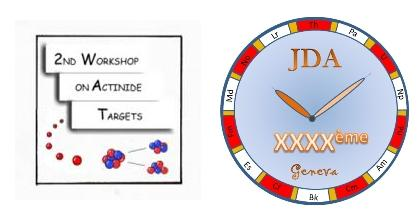Speaker
Dr
António Pereira Gonçalves
(Instituto Tevnológico e Nuclear)
Description
Considerations on the U-Fe-B ternary system
M. Dias1,2, I.C. Santos1, P.A. Carvalho2, M.Bohn3, O. Tougait4,
H. Noël4, A.P. Gonçalves1
1Dep. Química, Instituto Tecnológico e Nuclear/CFMC-UL, P-2686-953 Sacavém, Portugal
2Dep. Eng. Materiais, Instituto Superior Técnico, Av Rovisco Pais, 1049-001 Lisboa, Portugal
3Departement DRO/Geosciences Marines, Ifremer Centre de Brest, B.P. 70-29280 Plouzane, France
4Laboratoire de Chimie du Solide et Inorganique Moléculaire, UMR CNRS 6511, Université de Rennes 1, Avenue de Général Leclerc, 35042 Rennes, France
Uranium based intermetallic compounds frequently show unusual ground states and behaviours, such as unconventional superconductivity, coexistence of magnetic order and superconductivity, heavy fermion behaviour, etc. Ternary intermetallic borides of AMxBy type (A = actinide or rare earth; M = d-transition metal) have also attracted considerable interest due to their large diversity of physical characteristics, which extend from permanent magnetism with high coercive fields (like in SmCo4B) to unconventional magnetic ordering (as seen in UNi4B). However, the study of the U-Fe-B ternary phase diagram was far from being complete. Partial results on the isothermal section at 800ºC for this system were first reported, with the identification of two compounds, UFeB4 and UFe3B2 [1,2]. In this contribution we will present an overview of our recent work on the U-Fe-B ternary system, including the study of its isothermal section at 950ºC, the liquidus projection and selected vertical section.
Over 70 alloys, with general xU:yFe:zB compositions, were prepared by arc-melting the desired amounts of the elements, the melting process being repeated at least three times in order to ensure homogeneity. No losses higher than 1 wt.% were observed. The high cooling rate of the solidification process enabled to follow the solidification path of the alloys under non-equilibrium conditions. Subsequent heat treatments at 950 °C allowed inferring the transitions leading to equilibrium. The as-cast and annealed alloys were characterized by powder X-ray diffraction (PXRD), scanning electron microscopy (SEM), complemented with Energy Dispersive Spectroscopy (EDS), electron microprobe micro-analysis (EPMA), differential thermal analysis (DTA) and Electron Backscatter Diffraction (EBSD). Single crystal X-ray diffraction studies were also performed for some of the ternary compounds.
The U-Fe-B ternary system is considerably richer than what was reported before. A total of five ternary compounds were identified at 950ºC: in addition to the previously reported UFeB4 and UFe3B2, three new compounds, UFe4B, U2Fe21B6 and UFe2B6 were found to be stable at this temperature. However, all these ternary compounds are formed by peritectic reactions, being difficult to obtain as single phase samples. Moreover, only for the UFeB4, UFe3B2 and UFe2B6 compounds it was possible to get small single crystals suitable for X-ray diffraction studies. They have confirmed that UFeB4 and UFe3B2 crystallize in the YCrB4 and CeCo3B2 -type structures, respectively, and indicated that UFe2B6 is isostructural with the CeCr2B6-type [3]. Moreover, in the case of the UFeB4 compound it was found a cooperative (concommittant ?) growth of the YCrB4 and ThMoB4 type structures. For the other compounds, only PXRD measurements could be done, which indicate that UFe4B crystallizes in a structure type related to the CeCo4B-type and that U2Fe21B6 most probably crystallizes in the Cr23C6-type. In order to get more information on the crystal structures of these last two compounds, EBSD studies were preformed. They show that U2Fe21B6 really crystallizes in the Cr23C6-type structure and that the pattern of UFe4B is better explained by the Lu5Ni19B6-type simulation.
A cascade of peritectic reactions was found to exist along the U:(Fe,B)=1:5 line [4]:
L + UB4 UFeB4
L + UFeB4 UFe3B2
L + UFe3B2 UFe2 + UFe4B
The solidification paths show that the formation temperatures of the compounds decrease in the above order. Solidification ends with the ternary eutectic of UFe2 + UFe4B + -Fe at 980 ºC. The liquidus surface of the U-Fe-B ternary system is complex, with the presence of at least eighteen invariant points. The UFeB4 and UFe3B2 have large primary crystallization surfaces, but for the other three compounds they are small and are far from their nominal composition. All this information represents fundamental knowledge for the synthesis of pure compounds, necessary for the physical properties characterization.
Acknowledgments
This work was partially supported by FCT, Portugal, under the contract No. PTDC/QUI/65369/2006 and by the exchange Program FCT/CNRS 2009-2010.
References
[1] Valyovka, I.P., Kuzma, Yu.B., New uranium borides with the structure of YCrB4 type, Dop. Akad. Nauk Ukr. RSR, A: Fiz.-Tekhn. Mat. Nauki (1975) p-652.
[2] Valyovka, I.P., Kuzma, Yu.B., New ternary borides with structures of CeCo3B2 and CeCo4B type, Dop. Akad. Nauk Ukr. RSR, A: Fiz.-Tekhn. Mat. Nauki (1974) p-1029.
[3] Dias, M., Carvalho, P.A., Pereira, L.C.J., Santos, I.C., Gonçalves, A.P., Studies on the new UFe2B6 phase, J. Alloys Compd., in press.
[4] Dias, M., Carvalho, P.A., Dias, A.P., Bohn, M., Franco, N., Tougait, O., Noël, H., Gonçalves, A.P., Cascade of peritectic reactions in the B-Fe-U system, J. Phase Equilib. Diff., in press.
Primary author
Dr
António Pereira Gonçalves
(Instituto Tevnológico e Nuclear)




